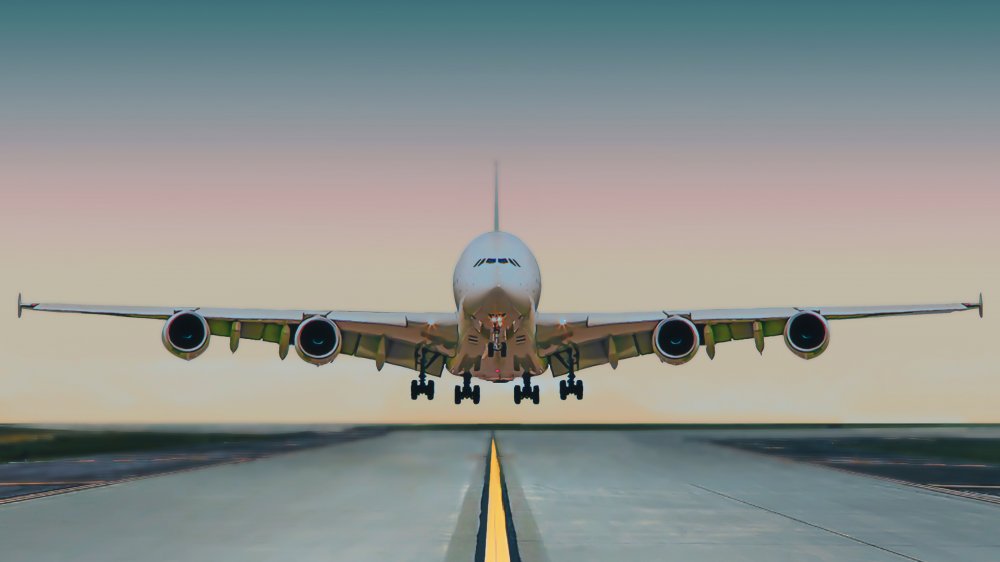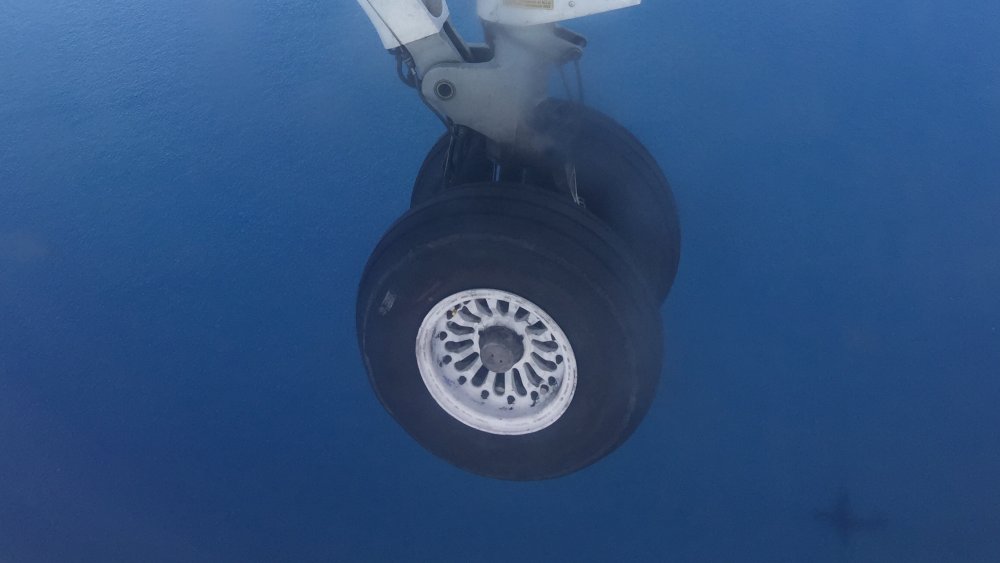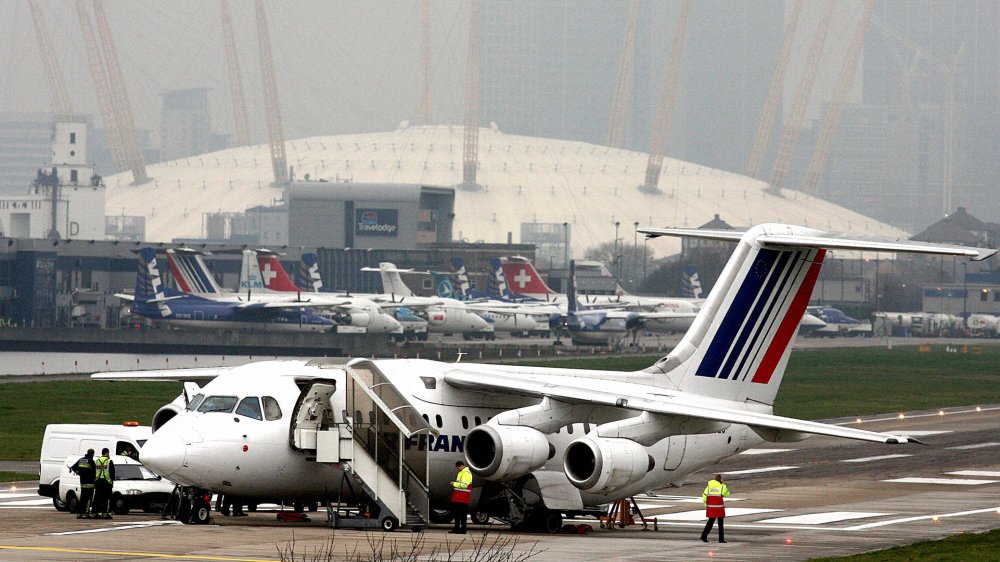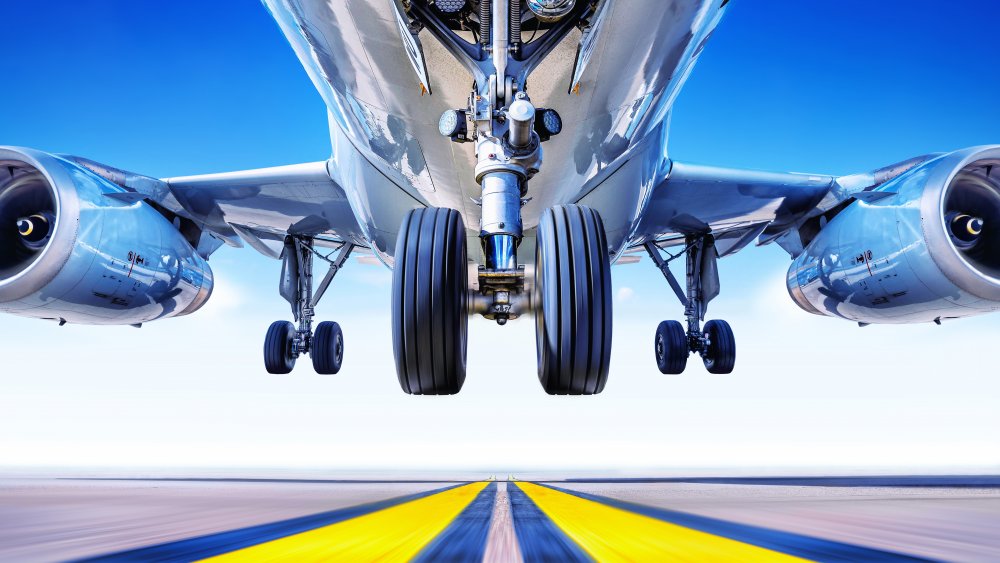The Reason Plane Tires Don't Explode During Landing
"The bigger they are, the harder they fall" isn't just a cliché you say about powerful people. According to pioneering geneticist, physiologist, and biometrician J.B.S. Haldane, "You can drop a mouse down a thousand-yard mine shaft; and, on arriving at the bottom, it gets a slight shock and walks away, provided that the ground is fairly soft. A rat is killed, a man is broken, a horse splashes." Let's all just ignore the horrifying question of how Haldane learned these things.
What about the tires on a Boeing 747 aircraft? For context, Boeing 747s weighs 403,000 pounds when empty, per How Stuff Works, and 875,000 pounds at max weight. And according to Business Insider, a plane lands at 170 miles an hour — yet you've probably never seen a news story about an airplane tire bursting like a horse thrown down a mineshaft. Perhaps it's because Haldane couldn't perform his rigorous observational studies on an airplane, but it seems more likely that the lack of horse and tire comparisons is explained by the fact that tires don't normally explode during landings.
Why airplane tires don't crack under pressure
A commercial jet typically has 20 tires, per Business Insider. Brandy Moorhead, the director of Off-Highway Product Development for Goodyear, explained that these tires are constructed using "a combination of proprietary synthetic rubber compounds" along with aluminum steel reinforcements and nylon and aramid fabrics. Moreover, they're filled with nitrogen, which is less sensitive to temperature and pressure changes than the air typically used in car tires. To ensure that the tires can withstand the weight of an aircraft, they're inflated six times as much as a car's tires.
A plane can usually land 500 times before the tires have to be retread. After seven retreads "the tire's no better than scrap rubber." So it takes roughly 3,500 landings for most tires to wheel-kick the bucket. So if ever you feel uneasy about a plane landing, just remember, those are wheels at the bottom of your air chariot, not horses.
Airplane tires aren't entirely pop-proof
Skeptical equines and other naysayers might say, "Hold your horses. Haven't there been multiple news stories in 2019 about exploding airplane tires?" Yes. It's important to note that airplane tires aren't entirely pop-proof. And much like our bubble, tires have burst in 2019. In June, a United Airlines flight skidded off a runway because its tires exploded mid-landing. Per the Independent, at least one person suffered a head injury while another injured their elbow. CNN reports that in September 2019, a Qantas Airways flight had to reverse course because one of its tires exploded midair. Obviously, the latter cause wasn't immediately caused by a landing, but it illustrates the more frightening fact that you don't even need the crushing weight of a plane to make a tire go kablooey.
Goodyear Aviation's 2017 "Aircraft Tire and Maintenance" manual explains that "over-inflation can cause uneven treadwear, reduce traction, make the tread more susceptible to cutting and increase stress on aircraft wheels. Under-inflation produces uneven tire wear and greatly increases stress and flex-heating in the tire, which shortens tire life and can lead to tire incidents." Furthermore, the manual warns that that tires exposed to higher-than average stress — such as when the plane lands at too fast or the brakes have been used an unusually high number of times — "should be removed and scrapped."
When wheels turn deadly
A damaged or improperly maintained plane can turn a tire explosion into a tragedy. According to the New York Times, an exploded tire might have caused a Mexicana Airlines jet to crash into a mountain in 1986, killing 166 people. Experts believed that a broken wheel brake may have dragged across the ground, causing the piece to overheat and in turn increase tire pressure to the point of bursting. Though planes have safety valves to prevent a dangerous buildup of pressure, sometimes fail-safes fail, and an exploded tire could have caused a fire to erupt on the plane. While the potential connection to the fire was unclear at the time, Boeing notes that wheel and brake fires generally result from "a buildup of grease on the axle during service or the application of excessive amounts of grease during wheel/tire changes and brake installations" which gets ignited by a heat source such as a brakes.
In 1991, blown tires caused a fire on a Nigerian Airlines jet. The plane subsequently crashed, and all 261 people on board perished. The Associated Press said it was the world's 10th-worst air disaster at the time. An investigation determined that the tires had insufficient pressure and that "other tires may have been below minimum pressures" required for safe travel. Sadly, maintenance personnel recognized the problem but chose not to address it.



